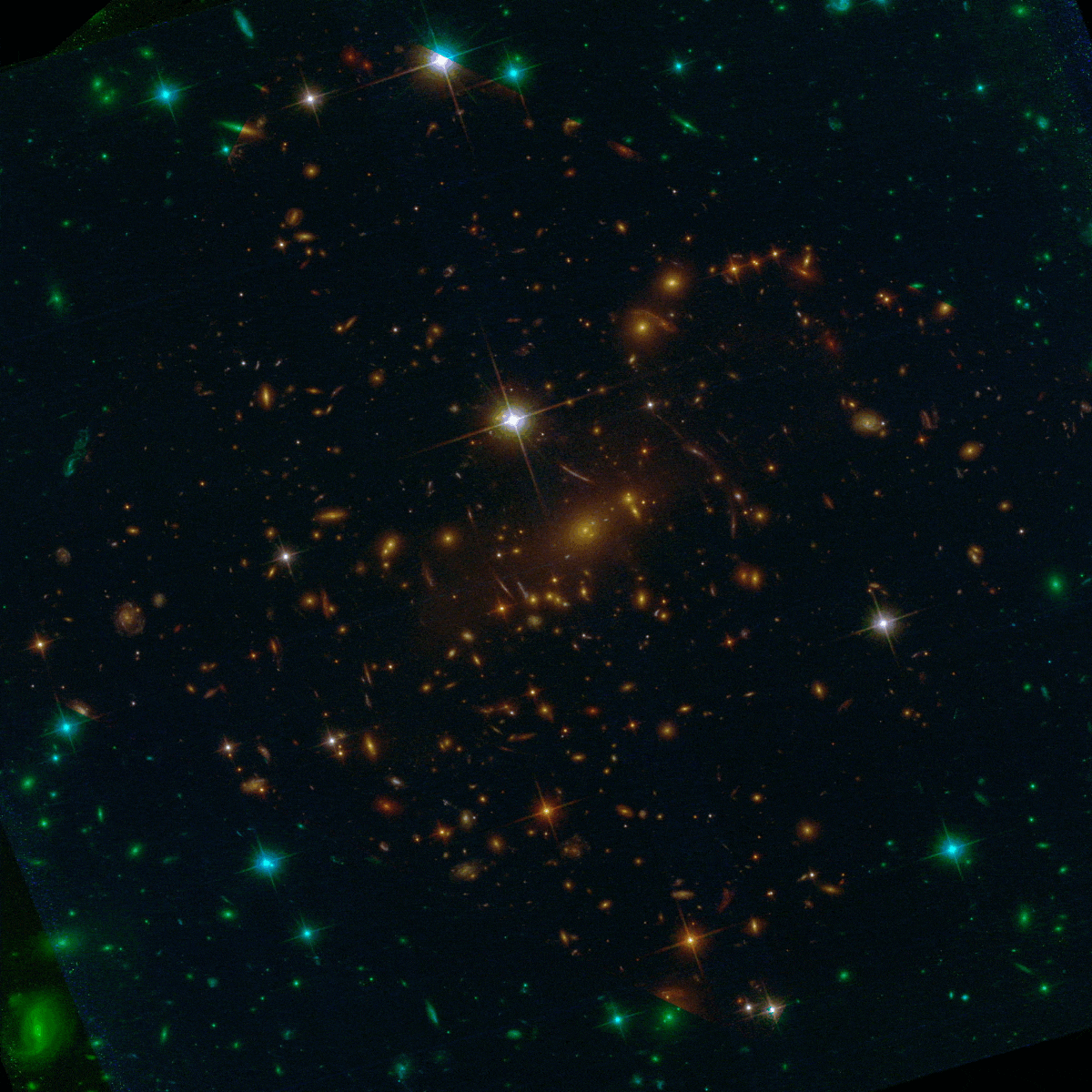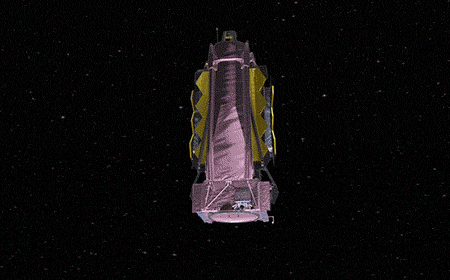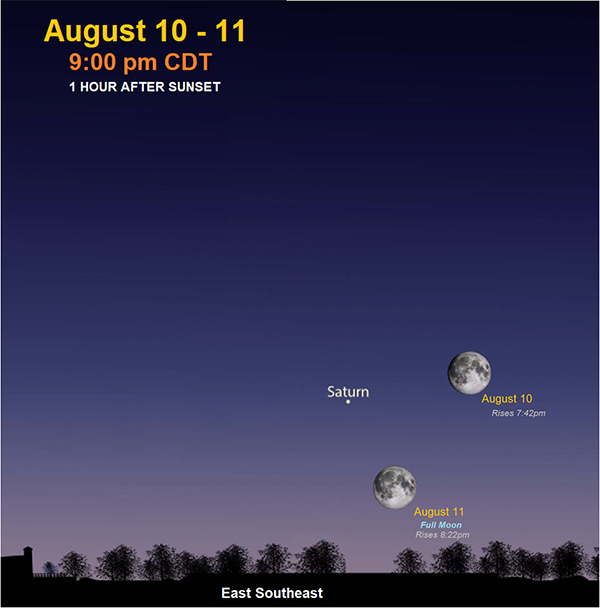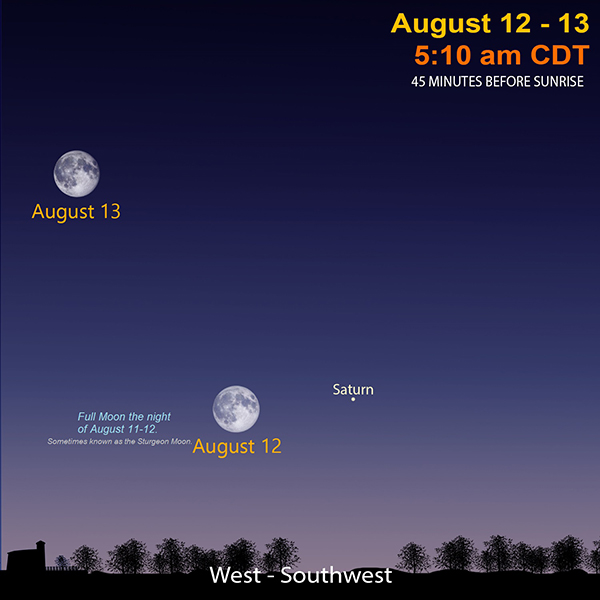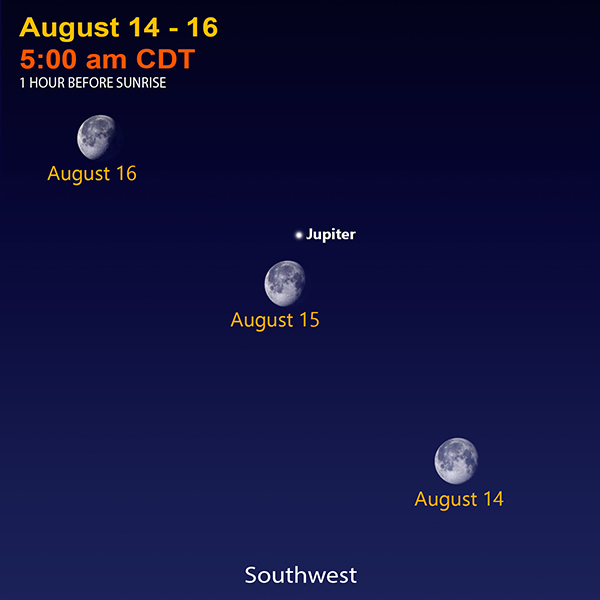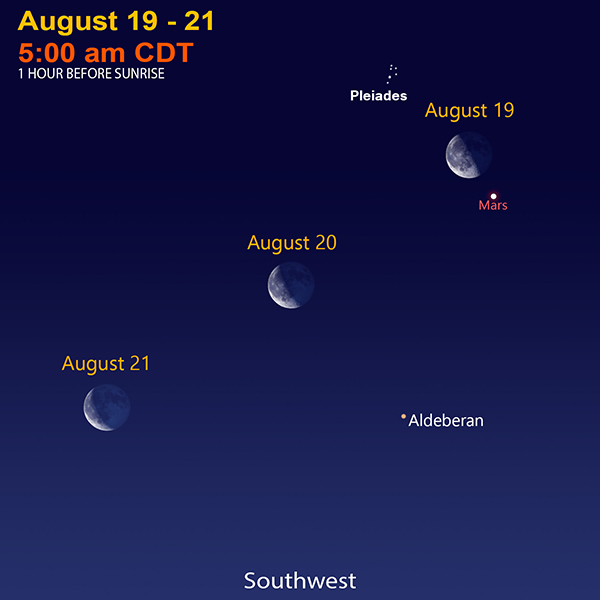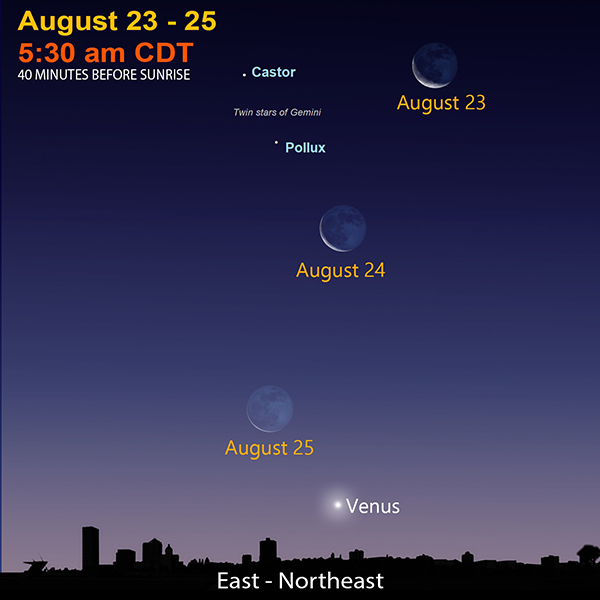Cosmic Curiosities
“The desire to reach for the stars is ambitious. The desire to reach hearts is wise.”
- Maya Angelou, American Author & Poet
Diving Into Deep Space
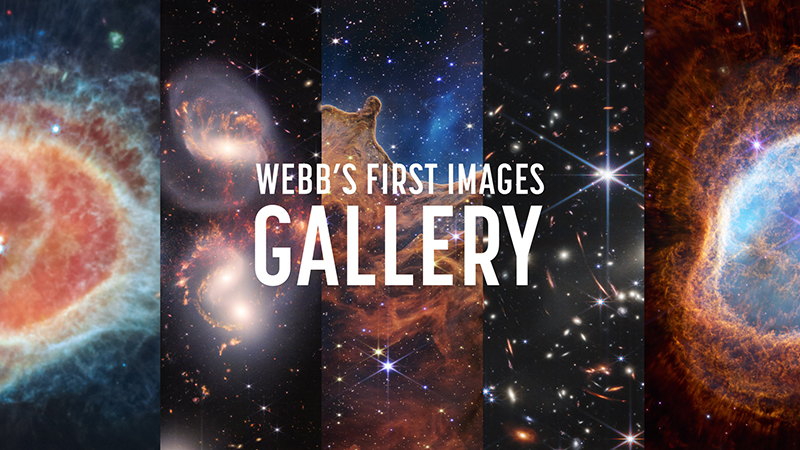
The new Webb images are stunning. Once again, we have expanded our vision and understanding of the cosmos with a sophisticated and spectacular telescope. Before we dive into deep space with Webb’s first image, let’s take a quick look at an even bigger telescope than Webb—though its main lens was less than two inches across.
Galileo
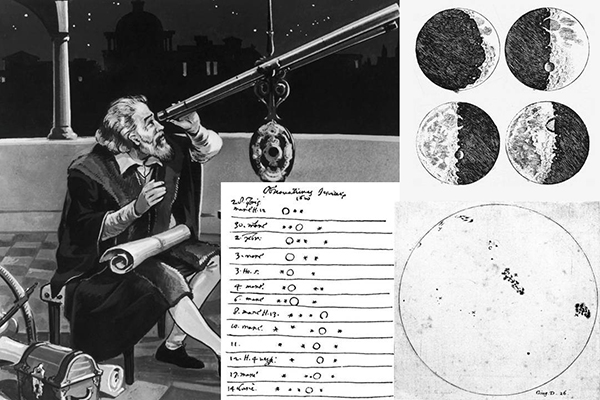
Galileo’s telescope may have been small compared to Webb’s 256-inch gold-plated mirror, but its impact on humanity was certainly enormous. The discovery of moons going around Jupiter was one of Galileo’s first revelations. This motion of the moons proved all sky objects did not circle the Earth. His telescope eyes also saw craters on the moon and spots on the sun. This showed the sky was not perfect and orderly as everyone had thought. It had blemishes that would be explained later with even better telescopes. It took people a very long time to accept Galileo’s findings.
Hubble
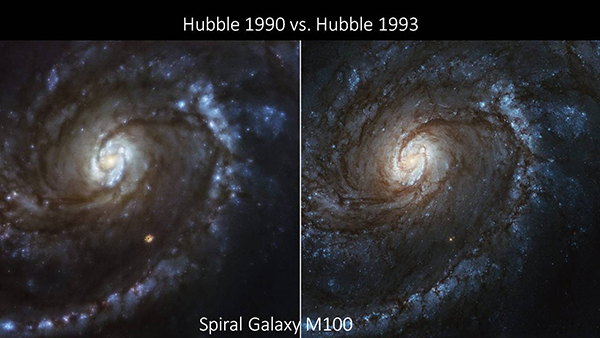
Another major milestone in telescope history was the Hubble Space Telescope—although it got off to a blurry start. Launched in 1990, its 94-inch mirror had a very tiny imperfection that prevented a pristine focus. A servicing mission in 1993 installed corrective lenses on it (glasses). The resulting images have been breathtaking, capturing peoples’ eyes and imaginations for 30 years.
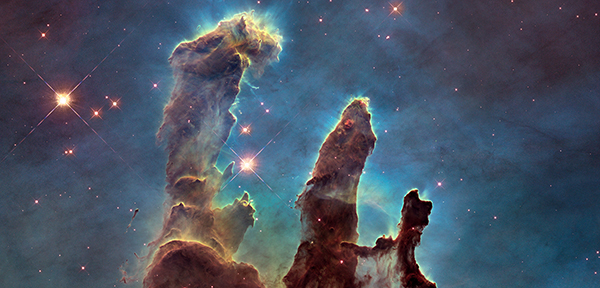
One of the most striking images Hubble took was the Eagle Nebula. The towering nebula was soon nicknamed “The Pillars of Creation.” It’s one of my personal favorites. The pillars are immense clouds, which are mostly hydrogen, but include other gasses and dust grains. The nebula is in the process of creating stars. The pillars were sculpted by radiation from nearby stars that recently formed. It is located in the constellation Serpens and is about 7,000 lightyears from Earth.
JWST
And today, we have the amazing James Webb Space Telescope (JWST). We’re going to explore JWST’s first image, released on July 11. It’s called Webb’s First Deep Field, or Galaxy Cluster SMACS (Southern MAssive Cluster Survey) 0723. Let’s start by comparing telescopes: Webb vs. Hubble. Both pictures are aimed at the exact same part of the sky.
The differences between these two deep space infrared images are striking. Webb can see farther, revealing faint galaxies never seen before. Webb’s image is also sharper. With its bigger mirror and light collecting availability, Webb’s resolution is 270% as sharp as Hubble’s. It will take astronomers months—maybe years—to sift through all the fine details buried in this far away image.
The total exposure time for the Webb’s first picture is 12.5 hours. This comes after adding up all the time from the telescope’s various filters and instruments. How long was the exposure time for Hubble’s deep-field image? Around 23 days! For comparison, your exposure time for a typical picture on your smartphone is 1/100 of a second.

With all these superlatives, you might think this Webb image covers a big part of the sky. The extreme opposite is true. The Webb Deep Field image measures less than a grain of sand held up to the sky at arm’s length. Go ahead, try it yourself. Find a grain of sand and hold it up to the sky. Then think of how many grains of sand you would need to fill the entire sky all around you.
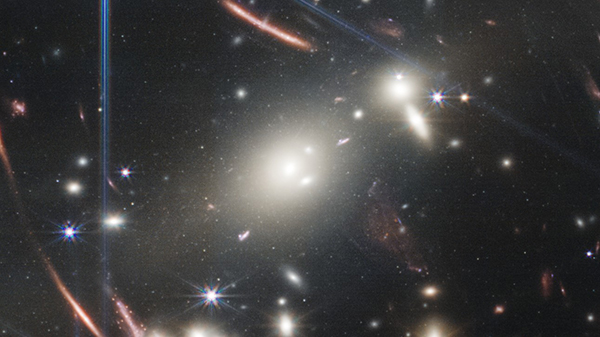
Center of Webb’s First Deep Field; Credit: NASA, ESA, CSA, and STScI
Let’s zoom in on the center of the Webb Deep Field image. The massive white glows are actually multiple galaxies—thousands of them known as a galaxy cluster. Recall that one typical galaxy contains hundreds of billions of stars! The galaxy cluster SMACS 0723 is 4,240,000,000 lightyears in the southern hemisphere constellation Volans the Flying Fish.
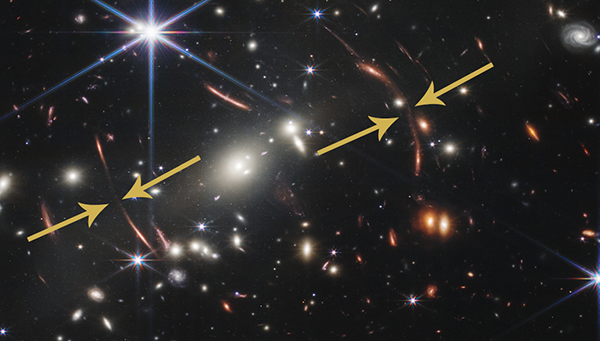
“Worm” Galaxies from Webb’s Deep Field; Credit: NASA, ESA, CSA, and STScI
Next, let’s explore these curvy orange “worm” lights. They are galaxies, too. Their distance is billions of lightyears farther away than the white galaxies that form the cluster. Why is there an arc-like shape to these galaxies? The SMACS 0723 cluster is so incredibly huge, its collective mass warps, or bends, the fabric of spacetime. This mammoth gravity well then bends the light of the distant galaxies giving them their worm-like appearance. This bending of the light is called gravitational lensing. It was first predicted by Einstein’s General Theory of Relativity more than 100 years ago. Like reading glasses or a magnifying glass, the galaxy cluster warps and enlarges the background galaxies. The “worm” galaxies appear big, but they are more than 13 billion lightyears away. That’s almost 9 billion more lightyears farther than the galaxies from the cluster!
Exploring the data from these very distant galaxies allows astronomers to study the universe when it was very young. It takes them back in time to when the first stars and galaxies formed shortly after the Big Bang. However, the light we see in Webb’s Deep Field image is some of the oldest light in the universe. The energy from these galaxies has been traveling to Earth for more than 13 billion years. Its light has stretched out and cooled to the infrared part of the electromagnetic spectrum.
It’s been a fantastic start for the James Webb Space Telescope. And it’s just the beginning! Who knows what discoveries lay in its future? Will it uncover a distant surprise that drastically shakes up our understanding of space? Will it prove more impactful than Galileo’s findings? Only time will tell.
Celestial Unicorn
No mythical animal captures the imagination as much as the unicorn. The story goes that these magical creatures only reveal themselves to those that are pure of heart. And, they are believed to have incredible powers that range from extracting poison from water to healing the sick and dying.
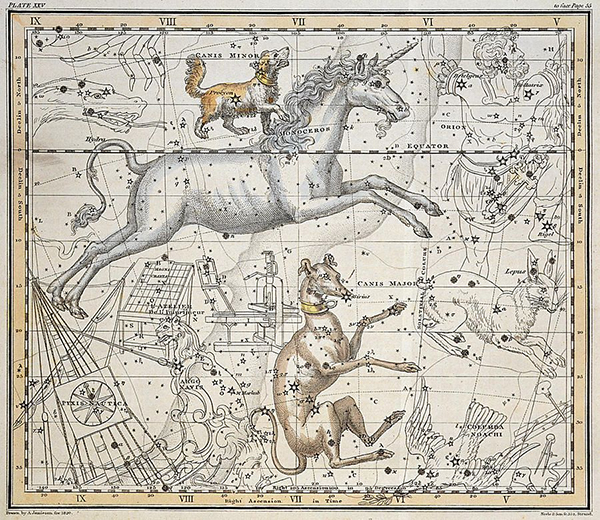
And, did you know? There is a unicorn in the sky!
The constellation Monoceros made its first appearance on a globe in 1612 or 1613 by Dutch cartographer Petrus Plancius. Monoceros is Latin for “unicorn.” Plancius may have selected the name because the unicorn appears in the Old Testament. There is also a Monoceros mentioned in an ancient Roman text by Pliny the Elder called Natural History. The creature described by Pliny sounds more like a relative of the unicorn; it has the body of a horse, the head of a stag with a single black horn in the center, the feet of an elephant, and the tail of a boar!
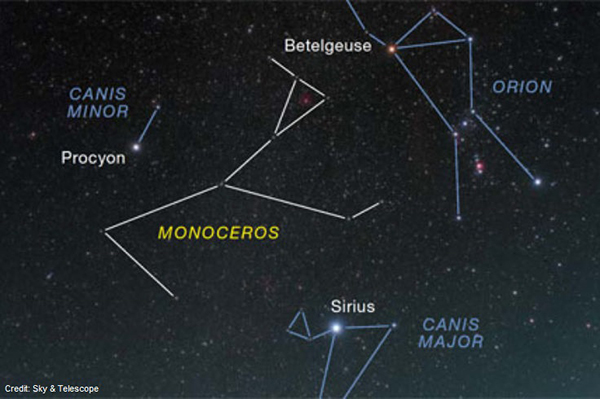
The stars of Monoceros are as elusive as the fantastic creature it’s based on. Why? Because the constellation is very dim. Please do not look for them at home if you have lots of city lights—they’re not visible. In a dark, clear sky, however, you can find Monoceros between two very bright constellations: Canis Major and Canis Minor, the big and little dogs. Nearby is the megawatt star pattern of Orion the hunter. You may also want to take advantage of a star map or a stargazing app on your smartphone in your quest to find Monoceros in the sky.
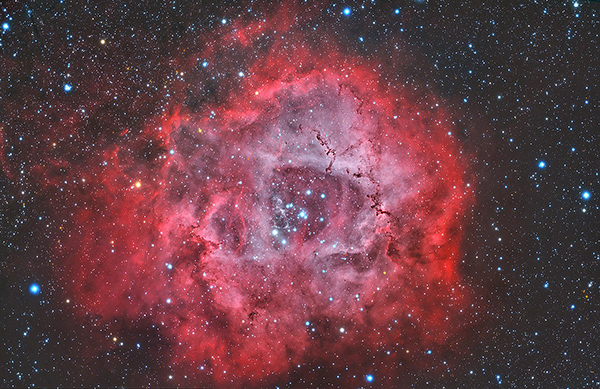
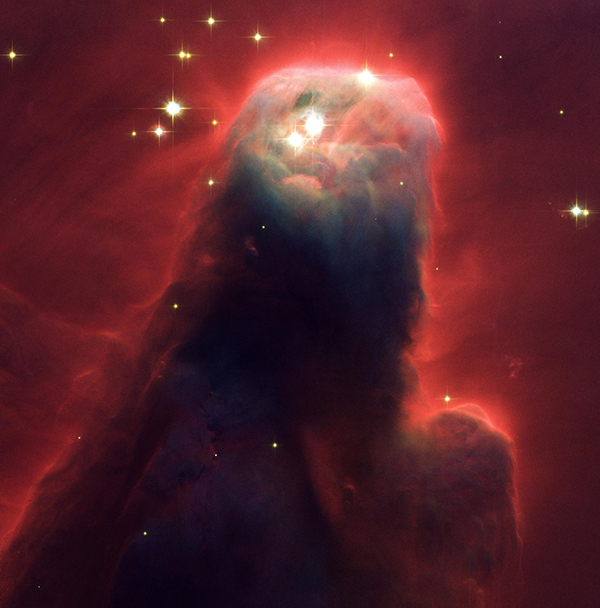
Monoceros is also home to deep-space objects that can really capture the imagination. One is the Rosette nebula; this huge red cloud of ionized hydrogen resembles a rose. This stellar nursery is forming hundreds of new stars over millions of years. The Cone nebula also calls Monoceros home. This giant billowing cone is also full of hydrogen and actively making stars. One might even say it looks like a space monster rising from a vast cosmic sea. These two nebulae could remind you of Beauty and the Beast!
Today, there are a number of animals that are said to have inspired the myth of the unicorn. One is the narwhal, often called the unicorn of the sea. Be sure to check out MPM’s Narwhal: Revealing an Arctic Legend exhibit during your next Museum visit.
Moon Outshines Meteors
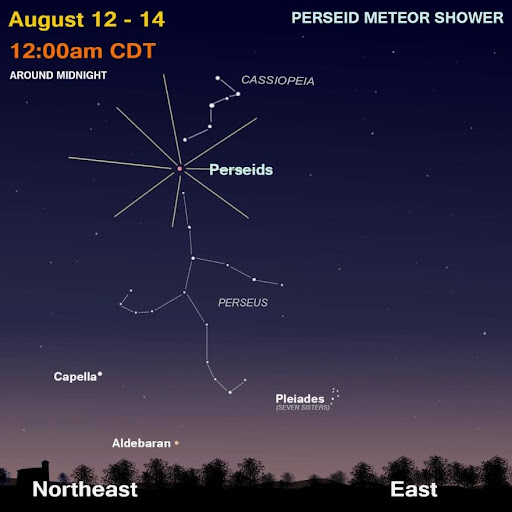
It’s usually a great sky show: Lie back on the green grass or a lawn chair and watch “shooting stars” dart across the sky. It’s the Perseid meteor shower! It happens every year around August 11-14. Typically, we might see 30-60 meteors per hour, if we are far from light pollution.
This year’s Perseid meteor shower, however, will lose its awesome factor to a very bright full moon. The moon’s glare will act like a huge streetlight in your backyard. You still may catch a few bright meteors burning up in our atmosphere—so not all is lost!
Space in Sixty Seconds
Webb is not the first time our view of the cosmos changed. Arguably, there was a more impactful telescope that was built more than 400 years ago…
Sky Sights
Saturn reaches opposition (opposite the sun—like a full moon) on the night of August 11-12. Watch the pair both rise and set! The ringed jewel will be close to the Moon on every night from August 10-13.
Next up, watch our Moon pass giant Jupiter. You will have to stay up somewhat late to see them together in the evening sky. At mid-month, Jupiter rises around 9:30 p.m. and is easily visible around 10:00 p.m.
Mars and the Moon pair up in the southwest morning sky from August 19-21. See if you can spot the glimmering little cluster of stars called the Pleiades nearby.
Venus and a waning crescent moon get together in late August. On the morning of August 25, the two brightest nightlights will be competing with the sun’s twilight. With a clear path to the horizon, you should have no problem identifying them.
Mercury is out of sight all month.
Use this chart to locate the moon and planets. You will have to get up early, though—about 4:30 a.m. here in Milwaukee.
Rise & Set Times (CDT) for Morning Planets in Milwaukee WI
| Planet | August 1 | August 31 |
|---|---|---|
| Saturn | 8:49 p.m. | 6:46 p.m. |
| Jupiter | 10:34 p.m. | 8:33 p.m. |
| Mars | 12:16 a.m. | 11:09 p.m. |
| Venus | 3:55 a.m. | 5:03 a.m. |
August Star Map
Sign Up
Receive this newsletter via email!
Subscribe
See the Universe through a telescope
Join one of the Milwaukee-area astronomy clubs and spot craters on the Moon, the rings of Saturn, the moons of Jupiter, and much more.
Follow Bob on social media
Twitter: @MPMPlanetarium
Facebook: Daniel M. Soref Planetarium


